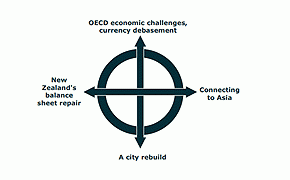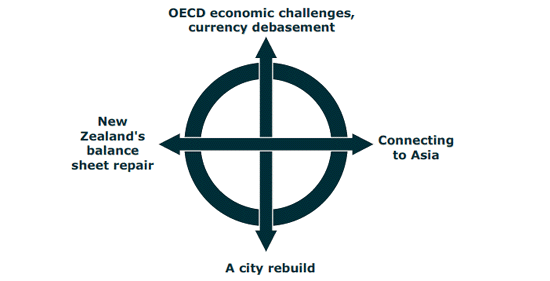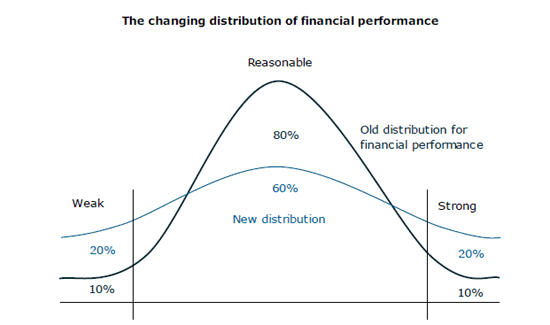
Over the next three business days we are continuing the detailed review by ANZ NZ's economics team of six key themes for 2013. The first one is here », the second one is here » and the third one is here »
By Cameron Bagrie*
 Our key aim in writing this article is to alert our readers to some of the wider economic forces at work.
Our key aim in writing this article is to alert our readers to some of the wider economic forces at work.
We want to highlight the inherent tensions that exist within the economic system, and to encourage readers to start thinking about the implications for their own businesses.
Ultimately, it is the average rate of growth over a number of years (and volatility around that growth) that matters, as opposed to what GDP growth will be in any single year.
The repercussions of the global financial crisis will continue to be felt for years.
Therefore, we would encourage our readers to think about the macro themes we outline below within a five-year time horizon.
THEME 4: A POLARISED COMPASS
The upshot:
New Zealand’s economic compass is being dominated by four facets: restoring semblances of health to the national balance sheet (including restrictive fiscal policy); the OECD’s economic challenges (and associated currency debasement which inflatesthe NZD beyond local fundamentals); upside that connecting to Asia is bringing (including robust soft commodity prices); and rebuilding a city.
Some facets are complementary, others are opposing, leading to dispersion and variability across economic indicators.
They will remain relevant for a considerable period.
New Zealand will lurch from bearing to bearing (i.e. from shock to shock), but one shock alone will not dominate which means financial market variables will oscillate as opposed to trend.
A polarised compass means greater performance variability across and within industries with the gap between good and poor businesses widening.
------------------------------------------------
New Zealand’s economic compass remains polarised as we lurch from strategic imperative to strategic imperative and these are also interacting with traditional cyclical drivers of the economic cycle.
At one extreme the economy remains notoriously unbalanced with a lopsided focus on the nontradable, rather than tradable sector, and a weak national balance sheet.

The next leg of the deleveraging process is restrictive fiscal policy. Restoring a modicum of health to the national balance sheet is a prerequisite to any sort of cyclical upturn taking hold.
Facing deleveraging and rebalancing imperatives we talk of a soup-bowl (U) or bathtub recovery prevailing over the martini glass (V).
The global scene remains wobbly across the OECD, and economic challenges are becoming a major “export” for some nations.
Currency debasement is inflating the NZD beyond local fundamentals, while an uncertain global scene keeps interest rates low.
We may like the latter – and the Auckland property market certainly does – but the combination is a mix to monetary conditions completely at odds with what balance sheet requirements dictate.
Currencies such as the NZD/USD trading out of line with domestic fundamentals is common and given it is likely to continue, such divergence must be matched by interest rate convergence. This argues for lower rates – as Australia is finding.
A positive income shock continues to manifest. Asia continues to grow quickly, despite challenges across a host of Western economies.
Asia remains “coupled” to the OECD, but is generating more internal demand.
We are seeing structurally higher demand for soft commodities as incomes rise. Asia is increasingly relevant for New Zealand as an export market, with Asia ex-Japan now accounting for more than a third of our merchandise exports, versus less than a quarter a decade ago.
Asia is supporting Australia, New Zealand’s largest trading partner. China is also now New Zealand’s second-largest source of tourists. We’re getting better connected to Asia via free-trade agreements.
But we must add a note of caution here: with exposure to the upside of Asia's potential comes increased vulnerability to adverse turns – both via Asia and indirectly via Australia.
The Christchurch impact
We need to rebuild our second-largest city. The impact channels are endless. Relative to the size of the economy, the estimated cost (more than 10 percent of GDP) is unrivalled globally.
Christchurch is a critical hub for the South Island, and an important component of the wider NZ.Inc story.
The construction response is pending and is due to peak in 2016, but will still add to economic activity for many years thereafter.
Christchurch’s events have altered building and insurance standards nationally (and costs). We need to rebuild a lot of destroyed domestic capital at a time resources need to be deployed to tradable-centric areas.
The rebuild risks blowing out the current account deficit unless consumption spending drops as a share of GDP.
Over time the costs of rebuilding Christchurch will hit consumers’ pockets via increased levies, higher building costs and insurance premiums and reduced government spending in other areas.
These shocks are complementary in some facets but opposing in others
Deleveraging is deflationary.
Positive commodity income shocks and natural disasters are not (indeed, we’d put some of the current Auckland housing inflation down to earthquake-related migration). The income shock is helping New Zealand get its balance sheet back in order, particularly in the rural sector via income generation (a higher denominator helps lower debt and deficit-to-income metrics).
Conversely, rebuilding Christchurch will involve dedicating resources to rebuilding domestic capital (i.e. housing and infrastructure) at a time when we’re also supposed to be investing in other regions and sectors to address our national indebtedness and imbalances.
We’re already seeing the consequences of these shocks interacting in variables such as the CPI and wages. Structural forces colliding means more dispersion across such measures.
To put these shocks in perspective in terms of their significance, an issue such as the “Leaky Homes” crisis, which hasn’t gone away and is hugely relevant, doesn’t make the cut.
And if we were ranking economic developments by national significance, Psa – which is decimating the kiwifruit industry – would not even make the top ten.
This is not to belittle the kiwifruit industry or those facing large building repair bills. It merely underlines the mammoth scale of the forces buffeting the New Zealand economy at present.
Lurching likely
Markets tend to lurch around as focus shifts from one theme to the other. Given the opposing nature of many of the shocks hitting the economy, we continue to expect a period of heightened volatility in financial variables as markets switch between different themes.
Christchurch is telling the RBNZ to hike rates.
A high NZD and contained CPI says the reverse.
Market pricing will see-saw over the year. Various themes will dominate individually from month to month, which will make an underlying assessment of the true state of affairs difficult.
Just because a theme is not dominating the data-flow over three months doesn’t mean it has become irrelevant.
We suspect New Zealand will be drawn to all four corners of the compass in 2013. Households still need to get balance sheets on a stronger footing and tighter fiscal settings will sap spending power out of the economy.
The outlook for retailing will remain tough. OECD wobbles will reappear (refer Themes 1 and 3). Ironically, this will exacerbate a likely wrong mix to monetary conditions (i.e. continued low interest rates and a high currency). The outlook for Asia and soft commodity prices looks buoyant for 2013. The rebuild is cranking up. Of course we have cyclical drivers of the economy to monitor too: interest rates are low and the housing market is responding.
Why not housing?
Some may ask why is housing (shortages or renewed enthusiasm) not included as a bearing on the compass?
There are three reasons.
First, we think the microeconomic evidence still points to a structural change in consumer behaviour (refer Theme 2).
Second, we expect balance sheet considerations to dominate supply-demand dynamics with the latter concentrated in only one region.
Third, if the housing market and borrowing keeps lifting in a cyclical sense, one or more of three things will happen. The OCR will rise. New Zealand will receive a credit downgrade. The RBNZ will likely lean more heavily on prudential policy.
Such forces will not alleviate supply-demand imbalances in the likes of Auckland which require a broader policy response. However, they will temper the potential for housing to turn into an enduring theme, and it is the enduring themes we are more focused upon.
Offsetting shocks means conflicting economic signals and mixed messages for businesses.
The historical “distribution” in terms of business performance within every sector has tended to be around 10-80-10. Ten percent are incredibly strong performers. Eighty percent perform okay, ranging from muddling through to being solid. Ten percent are constantly churned – the perennial underperformers.

This distribution is evolving more towards 20-60-20. Twenty percent of businesses are strong. Sixty percent are muddling through or solid. Twenty percent risk being churned.
Why the change?
Structural changes at the economy wide level also necessitate change at the core business level if firms are going to survive, let along thrive.
Microeconomic foundations need to be strengthened, with continued emphasis on doing the basics well, but also greater willingness to adapt to suit the changing environment. Firms need to get more strategic with their future direction and highlight themselves in a positive light rather than just muddle through. “She’ll be right” no longer applies in an increasingly connected and competitive global marketplace.
Microeconomic foundations need to be strengthened and they become far more of a key bellwether of success when a consistent macroeconomic picture is absent.
An average business can look very good in a strong performing economy. They are exposed in a grumpy growth or transitioning environment (refer Theme 2).
A larger gap between strong and weak businesses within sectors portends of a lot more consolidation to come across and within industries.
-----------------------------------------------------------------------------------
*This report was written by the ANZ New Zealand economics team which consists of chief economist Cameron Bagrie, head of global markets research David Croy, senior economists Sharon Zollner and Mark Smith, economist Steve Edwards, strategist Carrick Lucas, and rural economist Con Williams. It is used with permission. Theme 5 will follow tomorrow.
1 Comments
A good summary of the key issues facing NZ, thanks, albeit without explicit solutions to the conflicting issues presented.
My own view is to set fixing NZ's balance sheet as the first priority, and go from there. To have the right price signals for everyone to help that, needs the overvalued currency to be addressed- managing around other countries' currency debasement with some of our own in other words. Printing or borrowing internally, rather than from foreign investors, to pay for the government deficit would be a good start.
Connecting to Asia is fine, and indeed a better priced currency would help that, with exports, import substitution and tourism.
Rebuilding Christchurch can be managed within that paradigm; with some printed money if need be, so as not to choke off the other tradeable parts of the economy. The only limiter there should be real capacity constraints of labour and employment, and not adverse monetary conditions.
Am never sure why interest rates need to be at or near zero before currency management can happen, (as lower interest rates would seem unhelpful internally right now), but if they must, then so be it.
We welcome your comments below. If you are not already registered, please register to comment.
Remember we welcome robust, respectful and insightful debate. We don't welcome abusive or defamatory comments and will de-register those repeatedly making such comments. Our current comment policy is here.